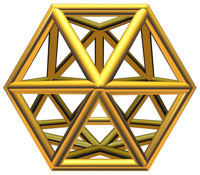RICHLAND, Wash., May 16, 2006 – Scientists have uncovered a class of gold atom clusters that are the first known metallic hollow equivalents of the famous hollow carbon fullerenes known as buckyballs. The researchers believe that what they call “hollow golden cages” can be used to trap many different kinds of atoms and influence chemical and physical properties on a smaller-than-nano scale. 
A gold atom cluster, the first known metallic hollow equivalent of the famous hollow carbon fullerenes known as buckyballs.
(Image: PNNL)
The fullerene is made up of a sphere of 60 carbon (C) atoms; gold (Au) requires many fewer -- 16, 17 and 18 atoms, in triangular configurations more gem-like than soccer ball. At more than 6 angstroms across, or roughly a ten-millionth the size of this comma, they are nonetheless roomy enough to cage a smaller atom. “This is the first time that a hollow cage made of metal has been experimentally proved,” said Lai-Sheng Wang, the lead corresponding author of a paper about the study. Wang is an affiliate senior chief scientist at the Department of Energy’s Pacific Northwest National Laboratory and professor of physics at Washington State University.
The experiments were buttressed and the clusters’ geometry deciphered from theoretical calculations led by Professor Xiao Cheng Zeng of the University of Nebraska and co-corresponding author. Wang, who worked in the Richard Smalley lab that discovered buckyballs, is part of a large cluster of researchers who have spent much of the past decade attempting to find the fullerene’s kin in metal. But their search has proved difficult because of metal clusters’ tendency to compact or flatten.
Experiments at the PNNL-based W.R. Wiley Environmental Molecular Sciences Laboratory in Richland elicited the photoelectron spectra of clusters smaller than Au32, which had been theorized as the gold-cage analog to C60 but ruled out by Wang’s group in an experiment that showed it as being a compact clump. They instead turned their attention to clusters smaller than 20 atoms, which earlier work by Wang’s group showed were three-dimensional -- a golden pyramid -- but larger than 13 atoms, known to be flat. The spectra and calculations showed that clusters of 15 atoms or fewer remained flat but that all but one possible configuration of 16, 17 and 18 atoms open in the middle. At 19 atoms, the spaces fill in again to form a near-pyramid.
“Au16 is beautiful and can be viewed as the smallest golden cage,” Wang said. He pictures it as having “removed the four corner atoms from our Au20 pyramid and then letting the remaining atoms relax a little,” and thus opening up space in its center. It and its larger neighbors are stable at room temperature and are known as “free-standing” cages -- unattached to a surface or any other body, in a vacuum. “When deposited on a surface, the cluster may interact with the surface and the structure may change.”
Wang said he and his co-workers suspect “that many different kinds of atoms can be trapped inside” these hollow clusters, a process called “doping.” “These doped cages may very well survive on surfaces,” suggesting a method for influencing physical and chemical properties at smaller-than-nano scales, “depending on the dopants,” he said.Wang’s group has not yet attempted to imprison a foreign atom in the hollow Au cages, but he said they plan to try. A paper about their research can be found in the online edition of the Proceedings of the National Academy of Sciences.
For more information, visit: www.pnl.gov